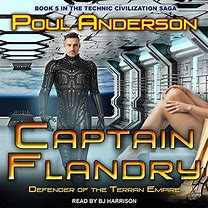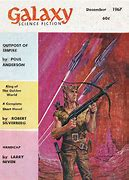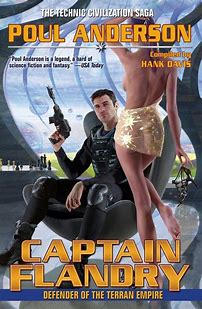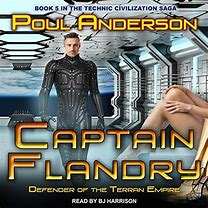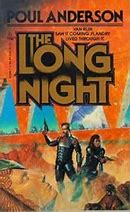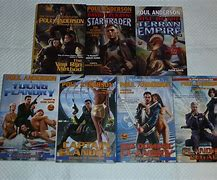Mayor Uriason blows his stack at three "traitors" who propose to join the outbackers but then, to Ridenour:
Saturday, 31 August 2024
More Surprises
Expositions
Characters expounding to each other is a major feature of the text of this story. A young City-dweller speaks non-stop for nearly two pages to Ridenour about his experiences among the outbackers. There was something that he did not understand about what he calls rituals and superstitions. We have already seen that the outbackers have ways of controlling Freeholder organisms that are not suspected by the Nine Cites. (Now only Eight because the outbackers have destroyed Domkirk.)
When Ridenour has recalled the monologue by the young man, he is joined on his hilltop by the outbacker woman, Evagail. Readers already know that she is a Mistress of a Skill. We are learning what that means. Meanwhile, she expounds to Ridenour. Because the star is F-type, actinic and ionizing radiation penetrates the heavy atmosphere and biochemistry founded on highly energetic compounds makes Freehold life more vigorous than Terran so that it evolves faster and colonists have to learn how to survive in the forest. The outbackers have developed some kind of relationship or interaction with their environment.
Material And Cultural Impoverishment?
A City-dweller's view of the outbackers: they have no fixed abodes, books, schools or connection with the human mainstream and hardly any metal or energy sources. Impoverished indeed - except that this account is completely mistaken. Two societies and cultures can coexist while one is dangerously uninformed about the other. How often does this happen on Earth now? Especially now when there is the technological capacity for constant disinformation - and demonization? How many politicians denounce every poll that goes against them as rigged? Well, one in particular... While reading a story like "Outpost of Empire," appreciate its exotic extra-terrestrial setting but also translate its human conflicts into their contemporary parallels. We read fictional history and live real history.
Friday, 30 August 2024
Ridenour And Nature
John Ridenour climbs a hill and looks across trees that stretch to the horizon. Like other Poul Anderson characters, Manse Everard and Dominic Flandry, Ridenour reflects that nature is vigorous before civilization. He also sees that the local equivalent of grass is silvery-green and trilobed. Anderson never assumes that the ground cover on other planets will look exactly like Terrestrial grass. Film adaptations of his works will have to reflect this. We should see instantly that the characters are somewhere else.
There are many descriptive details:
Everything Save The Wind
Maybe a new kind of warfare is possible. It depends on priorities, presuppositions etc. The outbackers manage to destroy a city without killing its population which makes sense for them because what they are against is urbanization, not the existence of other people. What they do is to capture Domkirk, order its evacuation, then nuke it with is own missiles. They have none of their own, of course.
Uriason continues to provide comic relief. He babbles, gobbles, orates and gibbers. Ridenour must escape from him "...or commit violence." (p. 75)
But the most interesting detail that I have found is that, between its evacuation and its destruction:
"...Domkirk stood empty of everything save the wind." (p. 73)
Regular readers will know that the wind often punctuates Poul Anderson's prose and comments on his characters' dialogues and actions. It is always present. And now it remains present even when everyone else has gone! We would not have noticed or commented on this if we had not commented on the wind so often before.
Two POVs
Viewpoint character John Ridenour has interviewed Mayor Uriason. Now alternative viewpoint character Karlsarm interviews two prisoners, Uriason and his companion. We strongly suspect that that companion is Ridenour and our suspicion is almost immediately confirmed when Ridenour introduces both himself and Uriason to their captor. We now see Ridenour as seen by someone else, more specifically as seen one other person, namely Karlsarm. We are also told plenty about Uriason's responses although not from his pov. He looks comical to Karlsarm. He also looks insulted and probably is although this is not confirmed directly because the narrative does not go inside his head. Poul Anderson fully controls narrative point of view. Many readers accept povs without reflecting on them. They might have noticed if this scene had been written by Frank Herbert because, in that case, the pov would have switched indiscriminately back and forth between all three characters. I think that a failure to control pov reflects a failure to control the writing process.
Thursday, 29 August 2024
Relevant Late-Night Other Reading
Ridenour And Karlsarm
We live what these stories describe. We watch interviews with mayors and other political leaders on TV while, at the same time, resistance fighters/terrorists post videos of their operations. In fact, we are now able to view more up-front, in-your-face details of such conflicts than Poul Anderson's Freeholders or other Imperial citizens appear to.
While reading about the destruction of Domkirk, remember cities devastated now. Fiction is comfortable reading until it hits reality.
Chronological Order
There are two kinds of fictional introductions. Whereas Donvar Ayeghen's fictional introduction to "The Star Plunderer" is simply the opening passage of this story as originally published, other Poul Anderson stories, collected in Trader To The Stars, The Trouble Twisters and The Earth Book Of Stormgate, acquired new fictional introductions and, in the case of the Earth Book, also a single fictional afterword only when collected. Nevertheless, all of these additional passages are reproduced in the Saga. Thus, in Volume III, the Earth Book afterword, fictitiously written long after the events of "The Star Plunderer," immediately precedes Ayeghen's fictional introduction fictitiously written an even longer time afterwards. Anderson gives us not only future history but also fictional historiography.
Uriason's Exposition
Uriason speaks for an entire page, then pauses for breath, enabling Ridenour to ask a question. Uriason continues to speak. He summarizes some Freeholder history:
Wednesday, 28 August 2024
Ridenour's Informants
John Ridenour holds fact-packed conversations with:
Dietrich Steinhauer, steward's mate on the Ottokar;
Lieutenant Muhammad Sadik, pilot of a supply barge;
an Arulian prisoner of war with whom his only common language is Eriau (regular readers recognize the relevance of this);
Rikard Uriason, mayor of Domkirk, who is proud to have visited Terra and to have a daughter studying on Ansa (an unexpected and welcome future historical back-reference).
Being a civilian xenologist employed by the Imperial government can get you in anywhere.
These guys expound a lot of the background to us, e.g., Ridenour to the Arulian:
"'But... Relationships between the Terran and Merseian Empires grew more and more strained. Armed conflicts became frequent in the marches. Freehold felt threatened..." (p. 57)
- etc.
However, despite his own loquaciousness, Ridenour thinks, while listening to Uriason:
"Good Lord... I have found a man who can out-lecture me." (p. 61)
Nordyke is a pleasant little settlement, surrounding a lake, with roses and jasmine blooming in its parks and merriment brawling in its taverns. We always find new details when rereading Anderson.
Conflict On Freehold
On Freehold, there is conflict both between human and Merseian-backed Arulian colonials and between human town-dwellers and forest-dwellers. This complicated situation exists only in this single story although, of course, there are similar conflicts on other planets in both earlier and later Technic History instalments. In the human settlement called Sevenhouses, there are:
Ridenour's Reflection
"Good God, [Ridenour] thought, if You do not exist - terrible God, if You do -..." (p. 50)
Many people believe that ultimate reality is a person whereas many others, including myself, believe that God is a personification. The most comprehensive spiritual philosophy in India acknowledges that some practitioners of yoga and meditation refer to the ultimate reality by a personal pronoun, "He," whereas others refer to that same reality as "THAT": personalism or impersonalism. Some people even try to say that reality is both. The Infinite has diverse and apparently contradictory aspects.
Are our lives controlled by many finite deities, by a single omnipresent, omniscient, omnipotent deity or by Fortuna? My friend, Andrea, has told me about Fortuna, a personification of chance. If there are many, are they manifestations of one? I want to give thanks for many aspects of life but the thanks have to be conditional. Fortuna, if she is in charge, is to be neither entreated nor thanked but accepted - and she favours the brave. Dominic Flandry does not prevent but at least delays the inevitable.
Thank you, John Ridenour, not for answers but for reflections.
Another Rearrangement Of The Technic History
The Earth Book Of Stormgate following the Polesotechnic League Tetralogy and The People Of The Wind;
The Long Night following the Flandry period and The Night Face;
The Saturn Game as a very short volume to be read first.
Thus:
the Tetralogy and the Earth Book tell the story of the League;
The People Of The Wind introduces Ythrians, Avalon and the Terran Empire;
the Earth Book recounts how Ythrians were contacted and Avalon was explored, then colonized;
The Long Night recounts how the Terran Empire was founded;
The Night Face and The Long Night recount what happened after the Empire.
That is everything with minimum reorganization of the original book publication order.
Addendum: Correction. That was not everything. It left out "Sargasso of Lost Starships" which I suppose would have to be included in The Long Night after "The Star Plunderer."
Tuesday, 27 August 2024
A Transparent Plot Device
As the Germanian merchant spaceship, the Ottokar, approaches Freehold, John Ridenour watches the planet in the viewport. He is joined by a young Germanian steward's mate who is naive and uniformed but also intelligent enough to ask just the right questions to enable Ridenour to expound the physical parameters of Freehold for the benefit of Poul Anderson's readers. This character, Dietrich Steinhauer, exists only as a plot device although we are to imagine that he has a life before and after his conversation with Ridenour.
I am not disposed to summarize the details about Freehold right now. They are there to be read. However, I find it interesting that Anderson reminds us of the cosmic context of sf, and indeed of all fiction, by informing us through Ridenour that Freehold's sun lacks heavy elements not because it is old - it is not - but because it formed in a metal-poor spatial region, then wandered into this spiral arm. Cosmic processes operate continually whether or not we are aware of them.
Freehold was settled more than five centuries previously so there is a lot of history which the story merely hints at.
The History Beyond The Stories
I have already conformed to a cliche. The sf that we read is full of interplanetary and interstellar space travel. However, a future history could just be an account of events on Earth over several centuries or millennia without any reference to space travel. But the same basic point would still apply. That one planet would theoretically be able to generate an endless amount of literature as it has in the past. Freehold appears in only one story which alludes to its long prior history. Always think beyond the immediate story. Imagine a future history series written by an author who lives for several centuries.
Noticing Details
After four pages of unfamiliar Freeholder characters and settings, we encounter John Ridenour and might remember that Ridenour was with Flandry on Starkad. He - Ridenour, not Flandry - has travelled to Freehold in a Germanian ship. Germania, mentioned more than once elsewhere, is most notable as the home planet of a future Imperial usurper, Hans Molitor. Thus, "Outpost of Empire" gains immeasurably by being one instalment of a rich future history series instead of just a stand-alone story. But we knew that, of course.
Two Companion Volumes
Companion Volume
Fights
Poul Anderson learned how to write fights for pulp magazines and they stayed with him in later novels where they were less necessary. "Sargasso..." is full of fights. In the climax, Wocha, half-blinded, takes a lance between his ribs but breaks it off and throws it at Valduma, killing her. Thus, Donovan's slave and temptress both die. The Arzunians can be tired or distracted and thus cannot use their psychic powers all the time any more than a man can continue to exert himself when physically exhausted. Although the Arzunians seem to tap "'...some unknown cosmic energy source...'" (p. 425), "'...it takes a lot of nervous energy to direct that flow...'" (ibid.) Thus, an Arzunian will sometimes teleport away from a sword thrust but not always.
Donovan thinks that the defeated Arzunians will teleport to fringe Nebular planets, then:
"'...scatter, and try to pass as harmless humanoids.'" (p. 435)
Are we to understand that there are several other intelligent species indistinguishable from Terrans? No such species appear anywhere else in the Technic History. But then we already regard "Sargasso..." as a "play within the play," to use Shakespearean terminology.
Peace And Conflict
A TV discussion counter-posed violent mankind with peaceful civilization, making this seem like an irreconcilable antithesis. However, it was mankind that built civilization and it is civilization that contains the seeds of its own conflicts. We have to criticize the specific ways in which our own societies are organized, not just blame humanity as a whole. If we can recognize potential peace in mankind as well as causes of conflict in our own civilization, not just in those of our "enemies," then we might work towards a resolution. Poul Anderson's Psychotechnic Institute does address sanity on both the individual and the social levels but is overwhelmed by massive socioeconomic changes. However, psychotechnic science survives and succeeds later in this future history. Poul Anderson is the only sf writer among whose works it is possible to compare several alternative future histories.
Wildness And Domesticity
Valduma's telekinetic taunting of Donovan is like telepathy or like a conflict in Donovan himself. She sets the wild life that he could have had with her against the domesticity that he will have with a human wife. He could have become a god or a demon but instead will become fat and grey. Thus, this pulp story reflects on human life and age. Donovan defends the doggedness with which the Terrans have resisted the Arzunian attacks but acknowledges to himself that he does not really believe his own fine words. Thus, the conflict continues within Donovan. Poul Anderson puts more even into pulp space opera than we might have expected.
Of course the remnant of the Ganymede crew will escape from Arzun but the issues that have been raised remain.
Monday, 26 August 2024
Wind And Divided Loyalties
As the Terrans enter the partly ruined Arzunian city, it seems to them to be haunted and the ever-present wind blows snow in front of them - of course. Valduma, hiding nearby, practices her super-ventriloquism, telekinetically vibrating air molecules by Donovan's ears, saying that the Arzunians could free Ansa. There are three sides in this fight, or there were, but Donovan has at last transferred his loyalty to the Empire despite his former friendships with Arzunians. We approach the end of this story but will not quite get there this evening. This afternoon we visited an annual flower festival in a nearby church. There was a gravestone for a girl who died at the age of one month. One month. Think about it. Human life was around her but she did not know it. We take the longer route but it is worth it sometimes.
Old Life
When Hrolf Kraki's half-sister, Skuld, refers to what we have here called "Chaos," her names for it are "the Old Life," "freedom" and "wild magics." See Skuld. She argues that man and civilization are the enemies of all of this, of nature, of "...the brotherhood of Beast, Tree, and Water."
Thus, that single word, "freedom," has now been used in two opposite senses:
unrestricted natural activity preceding human action on nature - the latter regarded as human interference with natural processes;
specifically human freedom requiring a minimum of social order.
A tiger in the wild is free in the first sense but not in the second.
Whichever words are used, this passage in Hrolf Kraki's Saga presents another example of the cosmic conflict discussed in the previous post.
Freedom And Chaos
"...the outlaw darkness, the last despairing return to primeval chaos..." (p. 426)
We find a vast consistency.
Star Trek And The Technic History
Star Trek has more instalments than Poul Anderson's Technic History. ST also has multiple media and grew into a future history series and a multiple timelines history. The Technic History is a great deal shorter than ST but is long as prose future history series go. Length is relative. Trekkies must have a lot to discuss but the Technic History also gives us a lot. We can if we want, although I usually do not, compare:
Multiple Perspectives
Sunday, 25 August 2024
Divided Loyalties
"Sargasso of Lost Starships."
The Terran captain to an Ansan:
"'It's a question of unifying the human race, ultimately this whole region of stars...'" (p. 409)
The Ansan in conversation with an Arzunian:
Lucifer
"...as Lucifer must have looked back at Heaven." (p. 421)
Isaiah 14:12 apparently refers to the King of Babylon. Several Biblical passages converge into the concept of the Adversary.
12 “How lyou are fallen from heaven,
O 4Lucifer, son of the morning!
How you are cut down to the ground,
You who weakened the nations!
13 For you have said in your heart:
m‘I will ascend into heaven,
nI will exalt my throne above the stars of God;
I will also sit on the omount of the congregation
pOn the farthest sides of the north;
14 I will ascend above the heights of the clouds,
qI will be like the Most High.’
Arzunians
The Arzunians are tall, humanoid, god-like, helmeted, mailed and black-cloaked, armed with swords and spears. In other words, they are not science fictional extra-terrestrials! Poul Anderson could have deployed the easy enough explanation that these aliens use mental powers to appear as they do, as in "The Queen of Air and Darkness," but he does not do that in this story.
It is a surprise, even a shock, when Donovan greets these implausible beings by name:
"'Hello, Morzach, Uboda, Zegoian, Korstuzan, Davleka,' he said." (p. 412)
We had not known until now that he had been that close to them and could be again. Donovan's divided loyalty is the main theme of this story. The Arzunians want him to lead the Terrans into an ambush.
"The highway curved between great looming walls of cragged old rock, a shadow tunnel with the wind yowling far overhead and the sun a disc of blood." (p. 416)
I said that we would meet the wind again. Appropriately, it yowls, cliffs loom, the highway is shadowed and the sun is blood-coloured. Everything is in place for the last stand of a dying ancient race to be followed by a new beginning for Ansa in the Empire. When "Sargasso..." ends on p. 436 and The People Of The Wind begins immediately afterwards on p. 337, we enter an entirely different Imperial era. There is a similar transition in the Flandry sub-series from the opening two short stories to subsequent instalments. We pass from sword-fighting humanoid alien races, one such species horned, to more credible human colonists of extra-solar planets. A future history series incorporates disparate narratives.
Lawlessness
"'We're entering the home of all lawlessness,' said Donovan. 'The realm of magic, the outlaw world of werebeasts and nightgangers. Can't you hear the wings outside? These ghosts are only the first sign. We'll have a plague of witches soon.'" (p. 392)
Donovan exaggerates. The "ghosts" are telekinetic and will not be followed by werebeasts, nightgangers or witches. But this is clearly the premise for an sf-fantasy synthesis: scientific laws in known space but magical lawlessness in the Black Nebula; spacemen learning to adjust from science and aliens to magic and ghosts. CS Lewis' Ransom Trilogy suggests that this is a false distinction. Ransom encounters beings that are equally extra-terrestrial and supernatural.
"Ghost world, ghost army, marching through an echoing windy solitude to its own weird " (p. 408)
The rest of this paragraph makes clear that this description is metaphorical. The marching army comprises:
"The men of the Imperial Solar Navy..." (ibid.)
- but Anderson will later write heroic fantasies about men in long ships and their weirds.
Two Interstellar Communicators
"'Our subtronics are out, you know. We can't send information back...'" (p. 395)
In Poul Anderson's Technic History, instantaneous communication in interstellar space is not by "subtronics" but by modulation of hyperdrive pulses. Furthermore, this means of communication works only over a distance of about a light-year and the Ganymede is by now much further away from civilization than that. This is evidence that the story is a fiction within a fiction written in a period when hyper-drive modulation, although pioneered by David Falkayn, has not yet come into regular use. Instead, this story is set in an imaginary future when "subtronics," with a vastly greater range, has been invented.
"The Star Plunderer," is not only set earlier but also written either as a memoir or as a historical fiction purporting to be a memoir. This makes it harder to explain the transonic communicator which is mentioned just once and which could easily have been edited out of the text for the collected edition. Instead, we are left with a textual conundrum and can try to invent some imaginative rationalization for it.
Saturday, 24 August 2024
Theory
Imperial Propaganda
Friday, 23 August 2024
Dream And Tempest
The Dream and The Tempest are the two Shakespeare plays that link Poul Anderson and Neil Gaimain:
Gaiman's The Sandman: A Midsummer Night's Dream is about the first performance of the Dream before Auberon's court;
Gaiman's The Sandman: The Tempest is about the writing of The Tempest;
Anderson's A Midsummer Tempest is a sequel to both plays.
The Sandman and A Midsummer Tempest are each part of a fictional multiverse. Gaiman's characters meet in the Inn of the Worlds' End whereas Anderson's meet in the Old Phoenix: two free houses that are not part of any realm or domain.
Wind On Arzun
"She turned her back. The wind blew a thin hissing veil of dry snow across her ankles. A wounded man suddenly screamed out there in the dark." (p. 403)
A woman turns, the wind blows and a man screams. This early, in January 1952, Poul Anderson had already begun his practice of punctuating dialogue and action with the sound of the wind. There would have to be appropriate sound-effects in any screen adaptations. The Terrans and their Ansan companion have just arrived on Arzun. There will probably be more Arzunian wind as we continue to reread "Sargasso..."
Often the wind not only punctuates but also effectively comments but we in turn have commented on that before. This wind hisses... Readers are affected by what they read, and also recognize the richness of a text, even if they do not reflect on it.
We will continue to notice the wind or other such details in "Sargasso..."
A Dynamic Future History Series
If the Technic History were to be republished in its, necessarily slightly amended, original publication order, then I suggest that a collection of "The Saturn Game," "The Star Plunderer" and "Sargasso..." would have to be inserted between Mirkheim and The People Of The Wind. "The Saturn Game" is out of chronological order but that cannot be helped. It does not fit in anywhere else. (Of course it does come at the beginning of The Technic Civilization Saga, Volume I, The Van Rijn Method.) However, this proposed reading order would put "The Star Plunderer" and "Sargasso..." where they belong immediately before The People Of The Wind. The difference, of course, is that, in the original order, The Earth Book Of Stormgate comes after The People Of The Wind whereas, in The Technic Civilization Saga, Hloch's Afterword to the Earth Book comes immediately before "The Star Plunderer"! This shifting back and forth between perspectives generates the impression that the Technic History is continually forming and reforming itself before our eyes. It is a dynamic future history series.
Fictions Within Fictions
Fictions within fictions are a vast untapped source of potential creativity. Fictional characters have to read something. Often they refer to works that we have read, like Alice In Wonderland or Sherlock Holmes, but they must read something else as well. Poul Anderson's Time Patrol series cannot be published or sold in the version of New York inhabited by Time Patrolman Manse Everard so what did Poul Anderson write instead of the Time Patrol series in the Time Patrol timeline? This is not a question that anyone usually even thinks of.
We do know, because we are told, that Wells' The Time Machine and Anderson's Maurai future history series and There Will Be Time are published in the There Will Be Time timeline.
In Alan Moore's Watchmen, which is a comic strip, a character reads a comic strip. We see and read what he sees and reads and eventually want to know the outcome of this secondary or subsidiary story as well as that of the primary story. Both were filmed but separately, the inner story as an animation.
In Stieg Larsson's Millennium Trilogy, a very minor character is an actor who plays an irascible police inspector in a popular TV series. Thus, there could be two TV series, one of Millennium, the other about the inspector, with the same actor playing both the actor and the inspector.
But the truth is that authors and script writers are fully occupied with what they are already writing about.
A Judas
Searching the blog reveals a long list of Biblical references, including several specifically to Judas, but here is one that we might have missed:
"How does it feel to be a Judas?" (p. 403)
The word has become part of the language to such an extent that anyone called "Judas" does not like it and does not say, "But I don't believe that Biblical stuff!"
The Nebular planet is terrestroid and humanly habitable but Anderson writes just enough to get us to accept this. The planet is inhabited by humanoids who have preserved its environment despite its age. After the spaceship crash, the rest of the action is on the planetary surface.
Thursday, 22 August 2024
Serendipity And Some POVs
POV Cop Routine
In the opening sentence of the first narrative section of "Sargasso...," Martin hears whereas, in the concluding sentence of that section, Savage hopes so there has been shift of point of view (pov).
In the opening sentence of the second narrative section:
"He went over the flight plan with Martin." (p. 237)
- "He" being Savage so we might expect his pov to continue. However, this section reverts to Martin's pov.
Later sections give us other povs but only the first section has a shift of pov. On p. 241, there should maybe be a double space between two paragraphs to indicate a change between narrative sections. That exhausts my pov analysis of this story.
Criticism Of Science
Captain Martin criticizes science.
(i) Scientists made simplifying assumptions in order to handle problems.
Reply: Sure, but this way of handling problems works.
(ii) However Martin says that:
"'...the assumptions were obviously false.'" (p. 252)
Example: Newton's "inertia." No body moves "'...only by its own inertia...'" (ibid.) because it always influenced by something else.
Reply: Of course. "Inertia," like the whole of mathematics, is an abstraction that helps us to understand and act on concrete reality.
(iii) He adds that kinetic energy is motion, that potential energy is position and that there is no need to talk about "energy" in any absolute sense.
Reply: Now we run into my almost total ignorance of physics. However, "E = MCsquared" has practical consequences so it is helpful to talk about "E."
(iv) Martin acknowledges that energy, inertia, entropy and force are useful mathematical constructs but adds that it is semantically wrong to identify equations with reality.
Reply: But who does identify equations with reality? There are different philosophical theories of the nature of scientific theories. I listed three philosophical theories in an answer to an exam question but cannot remember them all now. But one philosophical theory is that scientific theories are just ways of talking about reality and nothing more.
But Poul Anderson would have known all this. He was just enjoying writing about a magician who used theories about science to criticize science.
Wednesday, 21 August 2024
"Superstition"
I have just reread "Superstition," having read it perhaps once before and remembered nothing. The story seems to come down on the side of magic working although I am not sure. What it does present is several excellent examples of how people interpret evidence.
If a rain dance does not bring rain, then there was some counter-influence so a warlock investigates and sets things right until a dance does work. If a radio does not work, then there is something wrong and it can be fixed.
"In all honesty, it was entirely possible that counter-belief had a counter-effect; one of the Coven professors had entertained a hypothesis that this was why magic had worked so ill in the Dark Ages." (p. 247)
The Dark Ages, that is us.
"Every year the Utes make medicine to keep Earth on her orbit; and Earth stays there. Use your common sense." (pp. 252-253)
(A man spreads powder in Hyde Park, London. Asked why, he says, "To keep elephants away." "But there are no elephants in Hyde Park." "Yes. Good powder, isn't it?")
On rereading again, I see that the ending is ambiguous. The sceptic suggests that "magic" is telepathy, precognition, psychokinesis, psychosomatics etc, with rituals necessary to focus mental powers, and that these phenomena can be scientifically investigated. The disagreement remains.
Historical Evidence
"Many [theists] will tell you, for instance, in considerable detail, that the Resurrection of Christ is better attested than most events we take to be historical." (p. 270)
It certainly is not. And, if it were, then the Resurrection would be not an article of faith but a fact on a par with World War II. People disagree in their interpretations of World War II and the same would then apply to the Resurrection.
That claim about the Resurrection is one that many people who have been brought up as Christians like to hear but how many adult converts to Christianity make the claim? Some do, of course. Every possible opinion exists. We each have to reach our own conclusions, not just accept what anyone else says, especially not about historical evidence.
(I found the above book particularly illuminating. One of its articles crystallized my thinking on the subject.)
Implications Of Science
In "Fantasy in the Age of Science," Poul Anderson lists implications of science:
Earth is not at the centre of the universe;
mankind is not unique among living things (I think that we are but not in the way that used to be thought);
life is a physical phenomenon;
emotions are functions of chemistry;
brains are analogous to computers;
"...one entire school of psychology even denies that the word 'consciousness' has any meaning." (p. 282)
Brains compute but computation alone does not generate consciousness. Behaviourists thought (still think?) that scientists could study only empirically observable phenomena which do not include consciousness. But we still have to be conscious in order to study. We know consciousness by being conscious and by recognizing conscious behaviour, not by observing an entity or substance called "consciousness." Consciousness is indefinable. That second last sentence translates as: "We are conscious of consciousness by being conscious and by being conscious of conscious behaviour, not by being conscious of an entity or substance called 'consciousness.'"
We cannot describe whiteness to a permanently blind man but need not describe consciousness to a permanently unconscious man.
The nature of consciousness and its relationship to being are the central questions of philosophy and I think that it is wrong to quote behaviourism without responding to it. We have discussed consciousness here before but maybe it will help to subdivide some propositions:
(i) Naturally selected organismic sensitivity to environmental alterations. (Self-explanatory, I think.)
(ii) Quantitative increase. (In this case, of organismic sensitivity.)
(iii) Quantitative change becomes qualitative change. (Solid becomes liquid becomes gas; quantitatively different wavelengths generate qualitatively different colours; cool becomes warm becomes hot becomes uncomfortable becomes painful becomes lethal.)
(iv) The transition from unconsciousness to consciousness is a qualitative change. (This is why we do not understand the transition and need to explain it.)
(v) Sensation is conscious sensitivity. (Thus, quantitatively increasing sensitivity has changed qualitatively.)
(vi) There is unconscious data processing in brains and in computers.
(vii) However, some organisms that have become conscious of their environments also process data consciously, i.e., they consciously think.
Neurons fire electrically and interact electrochemically. How does that generate consciousness? In itself, it does not. But a brain coordinates a central nervous system in a complex, sensitive, psychophysical organism and it is the organism that is conscious. We feel with our skins, not just with our brains.
Consciousness is a property of some organisms. It is not an independent or pre-existent substance.
We are unique on Earth in being able to think about this.
Compression And Expansion
Anderson writes that the universe:
"...seems to have begun as a kind of super-black hole, perhaps 15 billion years ago, everything compressed together in a tiny volume that then exploded." (p. 283)
He then asks:
"But how could something which held itself so tightly ever start expanding?" (ibid.)
- and provisionally concludes:
"It looks as if, under those conditions, the very laws of nature were radically different from those we know. There may not have been any laws of nature." (ibid.)
He suggests that science approaches its limits and becomes fantasy. However, this article was published in 1981. Since then, scientific cosmogony has advanced beyond the idea of an inexplicably exploding super-black hole. See a summary of the accounts given in other works by Anderson, here.





